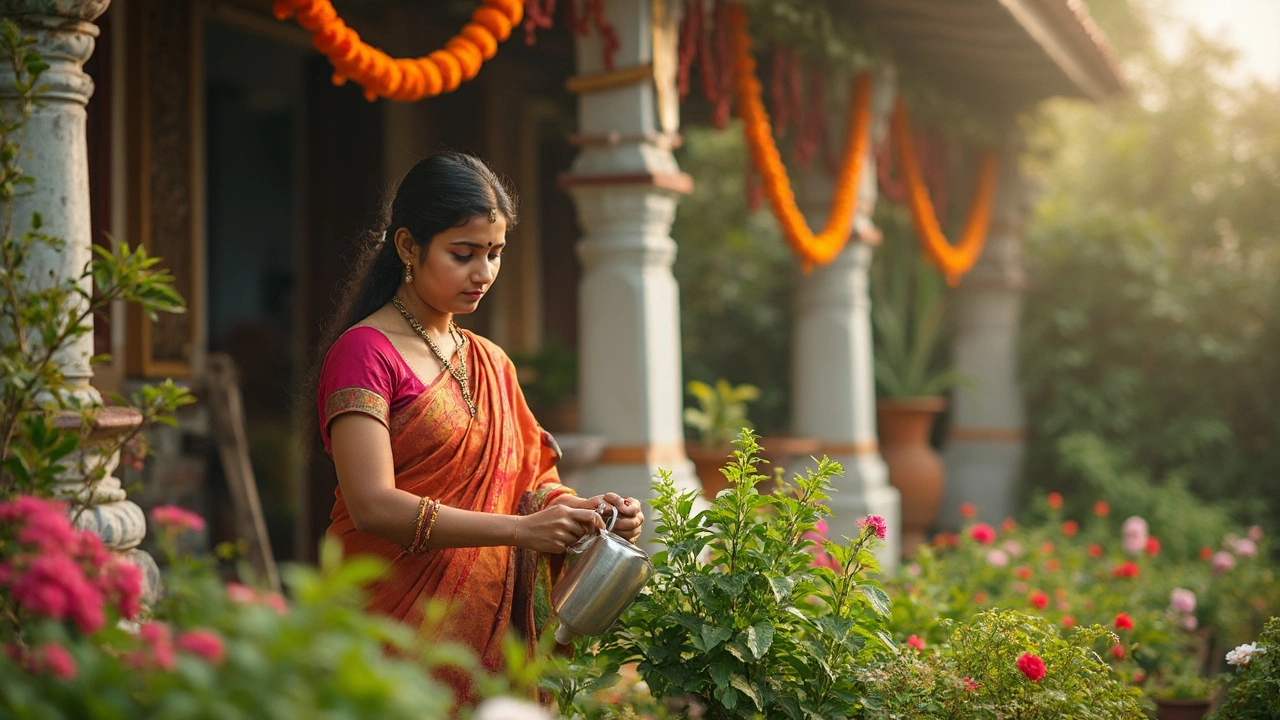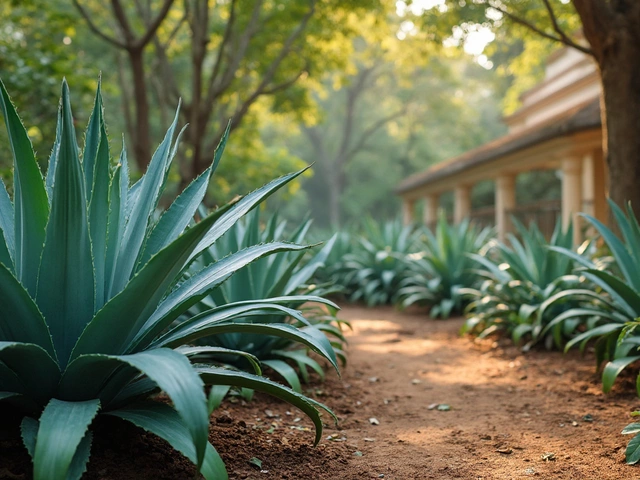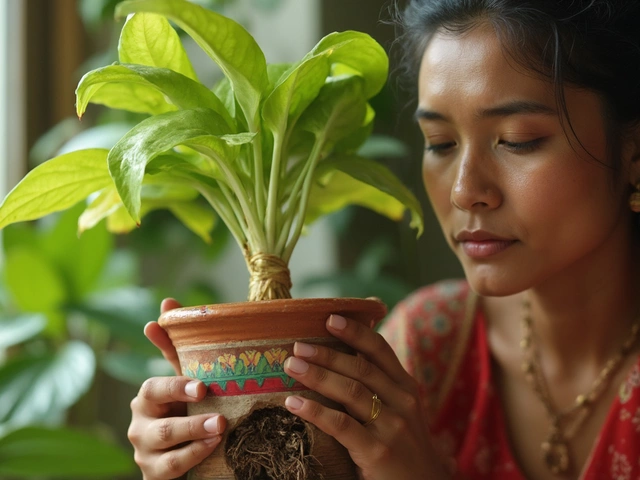If you walk past a typical Indian home, chances are you’ll spot a leafy green plant sitting right at the entrance or on a little platform in the middle of the courtyard. That’s Tulsi—the plant millions treat like family. We’re not talking about any ordinary houseplant. This one gets daily water, prayers, and often its own clay planter. There’s a reason why almost every household in India gives Tulsi a top spot.
Tulsi isn’t just another herb for cooking or decoration. People call it the “queen of herbs” and the most sacred plant in India. Why? It’s closely tied to daily life, old stories, and religious routines. In fact, Tulsi is one of the few plants found in every Hindu home, not just because it’s holy, but also because it’s tough, easy to grow, and useful in more ways than one.
If you’re into gardening and want to add something truly meaningful to your collection, Tulsi is a solid pick. It doesn’t ask for much—just a sunny spot, regular watering, and some love. Plus, it comes with a bonus: you get both a beautiful, green plant and a slice of genuine Indian culture, all in your backyard.
- Why Tulsi Is Considered Sacred
- Tulsi’s Role in Indian Homes and Temples
- How Tulsi Boosts Health and Well-being
- Growing Tulsi: Tips for Indian Gardeners
- Fun Facts and Legends About Tulsi
Why Tulsi Is Considered Sacred
Tulsi, also known as holy basil, isn’t just a plant in India—it’s a huge part of daily life and beliefs. People see Tulsi as more than green leaves. It stands for purity, health, and a special link to the divine. Stories from Hindu traditions often mention Tulsi as a favorite of the gods. In fact, in many Hindu homes you’ll hear how Tulsi is considered the earthly form of the goddess Lakshmi. Because of this, families treat Tulsi with real respect, almost like a living family member.
It’s not just about worship either. Rituals like “Tulsi Vivah”—where the Tulsi plant is married to Lord Vishnu—show just how important Tulsi is for connecting daily life with prayers and celebrations. If you walk into a temple, there’s a good chance you’ll find Tulsi leaves placed on idols or used in offerings. This isn’t optional; some religious ceremonies won’t even happen unless Tulsi is present.
“In Indian tradition, Tulsi is not only sacred, but is part of the household. It is looked after as carefully as a mother and worshipped every morning.” — Dr. Devdutt Pattanaik, mythologist and author
There’s science too. Tulsi is mentioned in ancient Indian texts like the Charaka Samhita—one of the oldest books on Ayurveda. Those texts call Tulsi a purifier for both the body and soul. No other plant gets this much attention in ancient Indian healing systems.
- Tulsi is required in major Hindu rituals, especially those involving Lord Vishnu or Krishna.
- People often water the plant first thing in the morning, believing it brings good luck and wards off negative energy.
- Tulsi is used to purify water and food before important prayers.
| Aspect | Description |
|---|---|
| Scientific Name | Ocimum tenuiflorum |
| Mentions in Texts | Vedas, Puranas, Ayurveda |
| Key Festivals | Tulsi Vivah, Kartik Purnima |
| Symbolism | Purity, Protection, Prosperity |
If you’re planning on adding sacred plant India to your garden, Tulsi tops the list not only for its deep roots in culture but because it’s the only plant that blends worship, tradition, and nature so powerfully together.
Tulsi’s Role in Indian Homes and Temples
Inside most Indian homes, Tulsi isn’t just another potted plant. It’s almost part of the household. Usually, you’ll find it growing in a special brick or stone planter, called a ‘Tulsi Vrindavan,’ in the courtyard or at the entrance. This isn’t by accident. People believe Tulsi brings good luck, cleanses the air, and protects families from bad vibes. It’s a daily thing—the first chore for many is to water Tulsi, light a lamp by it, and do a quick prayer. Even people who aren’t super religious often keep Tulsi because it’s said to keep away mosquitoes and freshen up the place.
Temples treat Tulsi with just as much respect. Priests use Tulsi leaves in all sorts of rituals, especially when offering prayers to Lord Vishnu and Krishna. There’s a rule in a lot of Hindu temples—if you don’t have Tulsi, the prayers are not complete. Some temples go through kilos of Tulsi every week just for worship.
"Tulsi is not seen as a plant but as a goddess—her presence in the home or temple is a blessing in itself," says Dr. Yogini Deshpande, a cultural historian from Pune University.
Check out how many folks actually integrate Tulsi into their day-to-day religious routines:
| Location | Percentage of Homes/Temples with Tulsi |
|---|---|
| Urban Homes (India) | 72% |
| Rural Homes (India) | 89% |
| Major Hindu Temples | Almost 100% |
Reasons people keep Tulsi at home or in temples:
- Daily worship and rituals
- Belief in its power to bring good fortune
- As a natural air purifier
- Medicinal use for everyday health issues
- Tradition—most grew up seeing Tulsi cared for daily
So when people talk about the sacred plant India is known for, they almost always mean Tulsi. It’s everywhere—from small apartments in Mumbai to ancient temples in Varanasi. And honestly, it’s the one plant nobody in India hesitates to give space to, no matter how tight things get.

How Tulsi Boosts Health and Well-being
When people talk about Tulsi, the top thing that pops up (after its spiritual vibe) is its massive health impact. It’s not just grandma’s cure in India—doctors and researchers back up a lot of these benefits. Tulsi has been used for centuries in traditional Indian remedies, and it’s made its way into teas, oils, and even skincare products.
The big deal? Tulsi leaves are packed with things like antioxidants, vitamins A and C, calcium, iron, and zinc. These are all things your body loves, whether you’re fighting off a cold or just trying to feel better each day. People use Tulsi for everything from easing stress to soothing a sore throat. If you brew some Tulsi tea when you’re feeling under the weather, you’re following a tradition that’s been around for ages.
- sacred plant India helps control blood sugar, which is super useful if you’re dealing with diabetes or just want to keep things level.
- The plant also fights inflammation—so it’s in homemade balms and even some toothpaste formulas now.
- Tulsi is known to boost immunity. During flu season, you’ll find folks chewing a couple leaves daily or tossing leaves into hot water to make a quick herbal tea.
- It’s a natural stress-buster and can help with anxiety. Some studies from India claim regular Tulsi use can lower stress hormones and help you sleep better.
Take a look at how Tulsi stacks up with its main nutrients:
| Tulsi Nutrient | Per 100g (Fresh Leaves) |
|---|---|
| Vitamin A | 5275 IU |
| Vitamin C | 18 mg |
| Calcium | 177 mg |
| Iron | 3.2 mg |
| Zinc | 0.81 mg |
Not everyone grows herbs for health, but Tulsi is one of those plants where you get both beauty and practical perks. It’s easy to slip a few leaves into your tea, or just chew one right off the plant (after washing, of course). Just be aware—if you’re pregnant or on medication, it’s smart to check with your doctor first since Tulsi is strong stuff.
Growing Tulsi: Tips for Indian Gardeners
You don’t need to be a pro gardener to grow Tulsi at home. This is one of the easiest plants to take care of, even on a busy schedule. Still, a bit of know-how means you get a healthy, lush plant that thrives year-round.
First, pick a sunny spot. Tulsi loves sunlight—at least six hours a day. If you live in an apartment, a sunny balcony or even a windowsill can work. Don’t tuck it away in a shady corner if you want it to grow well.
Soil is a big deal with this plant. Go for well-drained, slightly sandy soil. Mix regular garden soil with a bit of compost to give the plant a nutrient boost. Avoid waterlogging at all costs, or Tulsi’s roots will rot.
While watering, keep things simple. Water when the top inch of soil feels dry. During peak summer, that might be every day; in winter, every other day usually does the trick. Always use a pot with holes at the bottom if you’re planting Tulsi in a container.
Want your Tulsi to turn bushy? Pinch off the tops of the plant once it’s about six inches tall. That little trick makes the plant grow more side branches and a fuller look. Remove any flowers if you want the leaves to keep growing longer, since flowering signals the plant to slow down new growth.
- Fertilize with cow dung or organic compost every month for the best results.
- Watch for pests like whiteflies or mealybugs. A spray of neem oil is usually enough to keep them away.
- Prune any dead or yellow leaves regularly—they slow down the plant’s growth.
If you plant Tulsi during the monsoon (June to August), the saplings have the best shot at taking root. Seeds usually sprout within a week or so if kept moist and warm.
Honestly, keeping a sacred plant India like Tulsi isn’t just about looks—once you start, you’ll notice the garden feels different. Whether it’s the smell, the butterflies it attracts, or just the little moment of calm you get while watering, Tulsi adds something special to the space.

Fun Facts and Legends About Tulsi
Tulsi isn’t just another green plant on the balcony—its story is packed with surprises and history that goes way beyond everyday gardening. Here’s what makes this plant stand out in every Indian home and why people treat it with such respect.
First up, Tulsi is at the center of some pretty wild legends. According to one of the most famous stories, Tulsi was once a woman named Vrinda. She was so devoted to her husband, a demon king, that Hindu gods had to get creative to overcome his powers. In the end, Vrinda transformed into the Tulsi plant, which is why many folks believe Tulsi is not just a plant—it’s a symbol of loyalty and faithfulness.
Tulsi is used in almost every Hindu ritual. People add Tulsi leaves to holy water and offerings. Even during big events like weddings and religious festivals, you’ll find Tulsi playing a role. Another interesting fact? Tulsi leaves never go stale when offered to gods, unlike regular flowers that wilt fast. That’s one reason Tulsi is considered extra special.
On the science side, Tulsi packs a punch with nutrients. Here’s a quick look at what you get from fresh Tulsi leaves, in this easy-to-read table:
| Nutrient | Amount per 10g Fresh Leaves |
|---|---|
| Vitamin C | 4 mg |
| Calcium | 11 mg |
| Iron | 0.5 mg |
| Antioxidants | High |
The plant’s got its own day too—Tulsi Vivah. This “wedding” happens every year after Diwali, where people ceremonially “marry” Tulsi to Lord Vishnu. The celebration marks the start of the wedding season in India, and it’s a fun way to bring families and neighbors together.
- Tulsi plants thrive even in small balconies, making them perfect for city gardeners.
- Its leaves are said to purify air and even keep mosquitoes away.
- Tulsi seeds sprout in just a week if you use fresh soil and keep them moist—no fancy equipment needed.
Since Tulsi is the sacred plant India relies on for both faith and daily life, it’s no wonder that so many households take its care seriously. It’s rare to find something that’s both deeply spiritual and so easy to grow, all rolled into one plant.





